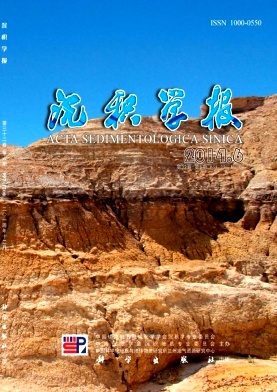|
[1]
|
罗建宁,张正贵,陈明,等. 三江特提斯沉积地质与成矿[M]. 北京:地质出版社,1991:1-231[Luo Jianning, Zhang Zhenggui, Chen Ming, et al. Sanjiang Tethyan Sedimentary Geology and Mineralization[M]. Beijing: Geological Publishing House, 1991: 1-231] |
|
[2]
|
刘增乾,李兴振,叶同庆,等. 三江地区构造岩浆带的划分与矿产分布规律[M]. 北京:地质出版社,1993:1-246[Liu Zengqian, Li Xingzhen, Ye Tongqing, et al. Sanjiang Area Tectonic Magmatic Belts and Mineral Resources Distribution[M]. Beijing: Geological Publishing House, 1993: 1-246] |
|
[3]
|
刘肇昌,李凡友,钟康惠,等. 扬子地台西缘构造演化与成矿[M]. 成都:电子科技大学出版社,1996:165-219[Liu Zhaochang, Li Fanyou, Zhong Kanghui, et al. The Western Margin of the Yangtze Craton Tectonic Evolution and Mineralization[M]. Chengdu: University of Electronic Science and Technology Press, 1996: 165-219] |
|
[4]
|
牟传龙,王建,余谦,等. 兰坪中新生代沉积盆地演化[J]. 矿物岩石,1999,19(3):30-36[Mou Chuanlong, Wang Jian, Yu Qian, et al. The evolution of the sedimentary basin in Lanping area during Mesozoic-Cenozoic[J]. Journal of Mineralogy and Petrology, 1999, 19(3): 30-36] |
|
[5]
|
陶晓风,朱利东,刘登忠,等. 滇西兰坪盆地的形成及演化[J]. 成都理工学院学报,2002,29(5):521-525[Tao Xiaofeng, Zhu Lidong, Liu Dengzhong, et al. The formation and evolution of the Lanping Basin in western Yunnan[J]. Journal of Chengdu University of Technology, 2002, 29(5): 521-525] |
|
[6]
|
宋玉财,侯增谦,杨天南,等. “三江”喜马拉雅期沉积岩容矿贱金属矿床基本特征与成因类型[J]. 岩石矿物学杂志,2011,30(3):355-380[Song Yucai, Hou Zengqian, Yang Tiannan, et al. Sediment-hosted Himalayan base metal deposits in Sanjiang region: characteristics and genetic types[J]. Acta Petrologica et Mineralogica, 2011, 30(3): 355-380] |
|
[7]
|
唐永永,毕献武,武丽艳,等. 金顶铅锌矿黄铁矿 Re-Os 定年及其地质意义[J]. 矿物学报,2013,3(3):287-294[Tang Yongyong, Bi Xianwu, Wu Liyan, et al. Re-Os isotopic dating of pyrite from Jinding Zn-Pb ore deposit and its geological significance[J]. Acta Mineralogica Sinica, 2013, 3(3): 287-294] |
|
[8]
|
罗君烈,杨友华,赵准,等. 滇西特提斯的演化及主要金属矿床的成矿作用[M]. 北京:地质出版社,1994:157-215[Luo Junlie, Yang Youhua, Zhao Zhun, et al. Tethyan Evolution and Mineralization of Major Metallic Ore Deposits in Western Yunnan[M]. Beijing: Geological Publishing House, 1994: 157-215] |
|
[9]
|
王义昭,李兴林,段丽兰,等. 三江地区南段大地构造与成矿[M]. 北京:地质出版社,2000:107-120[Wang Yizhao, Li Xinlin, Duan Lilan, et al. Sanjiang Area South of Tectonics and Metallogeny[M]. Beijing: Geological Publishing House, 2000: 107-120] |
|
[10]
|
马宏杰. 中国西南横断山地区新生代地层学及古环境变化研究[D]. 昆明:昆明理工大学,2013:132-148[Ma Hongjie. The study on the Cenozoic stratigraphy and paleoenvironmental changes in Hengduan Mountains located in Southwest China [D]. Kunming: Kunming University of Science and Technology, 2013: 132-148] |
|
[11]
|
Bhatia M R. Plate tectonics and geochemical composition of sandstone [J]. Journal of Geology, 1983, 91(6): 611-627 |
|
[12]
|
Roser B P, Korsch R J. Determination of tectonic setting of sandstone mudstone suites using SiO2 content and K2O/Na2O ratio[J]. Journal of Geology, 1986, 94(5): 635-650 |
|
[13]
|
李志明,刘家军,胡瑞忠,等. 兰坪中新生代盆地沉积岩源区构造背景和物源属性研究—砂岩地球化学证据[J]. 沉积学报,2003,21(4):547-552[Li Zhiming, Liu Jiajun, Hu Ruizhong, et al. Tectonic setting and provenance of source rock for sedimentary rocks in Lanping Mesozoie-Cenozoic basin: evidence from geochemistry of sandstones [J]. Acta Sedimentologica Sinica, 2003, 21(4): 547-552] |
|
[14]
|
宋玉财. “三江”沉积岩容矿贱金属矿床:发育特点与成矿模型[D]. 北京:中国地质科学院,2009:1-120[Song Yucai. "Sanjiang" the sedimentary rock hosted base metal deposits: development characteristics and metallogenic model[D]. Beijing: Chinese Academy of Geological Sciences, 2009:1-120] |
|
[15]
|
莫宣学,赵志丹,喻学惠,等. 青藏高原新生代碰撞—后碰撞火成岩[M]. 北京:地质出版社,2009:1-396[Mo Xuanxue, Zhao Zhidan, Yu Xuehui, et al. The Cenozoic Collision and Post Collision Volcanic Rock[M]. Beijing: Geological Publishing House, 2009: 1-396] |
|
[16]
|
Ding Lin, Kapp Paul, Wan Xiaoqiao. Paleocene-Eocene record of ophiolite obduction and initial India-Asia collision, south central Tibet [J]. Tectonics, 2005, 24(1): 1-18 |
|
[17]
|
侯增谦,潘桂棠,王安建,等. 青藏高原碰撞造山带:Ⅱ.晚碰撞转换成矿作用[J]. 矿床地质,2006,25(5):521-533[Hou Zengqian, Pan Guitang, Wang Anjian, et al. Metallogenesis in Tibetan collisional orogenic belt: Ⅱ. Mineralization in late-collisional transformation setting[J]. Mineral Deposits, 2006, 25(5): 521-533] |
|
[18]
|
曾荣,薛春纪,刘淑文,等. 云南金顶铅锌矿床成矿流体与流体的稀土元素研究[J]. 地质与勘探,2007,43(2):55-61[Zeng Rong, Xue Chunji, Liu Shuwen, et al. REE of fluid inclusion and ore-forming fluids in the giant Jingding Pb-Zn deposit, Yunnan[J]. Geology and Prospecting, 2007, 43(2): 55-61] |
|
[19]
|
徐晓春,谢巧勤,陆三明,等. 滇西兰坪盆地西缘铜矿床矿物流体包裹体研究[J]. 矿物学报,2005,25(2):170-176[Xu Xiaochun, Xie Qiaoqin, Lu Sanming, et al. Fluid inclusion characteristics of copper deposits on the western border of Lanping Basin, Yunnan province[J]. Acta Mieralogica Sinica, 2005, 25(2): 170-176] |
|
[20]
|
张乾. 云南金顶超大型铅锌矿床的铅同位素组成及铅来源探讨[J]. 地质与勘探,1993,29(5):21-28[Zhang Qian. Pb isotopic composition of Jinding super-large Pb-Zn deposit in Yunnan province and discussion on the source of lead[J]. Geology and Prospecting, 1993, 29(5): 21-28] |
|
[21]
|
薛春纪,陈毓川,杨建民,等. 滇西兰坪盆地构造体制和成矿背景分析[J]. 矿床地质,2002,21(1):36-44[Xue Chunji, Chen Yuchuan, Yang Jianmin, et al. Analysis of ore-forming background and tectonic system of Lanping Basin, western Yunnan province[J]. Mineral Deposits, 2002, 21(1): 36-44] |
|
[22]
|
朱志军,姜勇彪,郭福生,等. 兰坪盆地古近纪沉积相类型及沉积环境演化[J]. 岩石矿物学杂志,2011,30(3):409-418[Zhu Zhijun, Jiang Yongbiao, Guo Fusheng, et al. Palaeogene sedimentary facies types and sedimentary environment evolution in Lanping Basin[J]. Acta Petrologica et Mineralogica, 2011, 30(3): 409-418] |
|
[23]
|
张峰,唐菊兴,陈洪德,等. 兰坪盆地演化与成矿特征[J]. 地质与勘探,2010,46(1):85-92[Zhang Feng, Tang Juxing, Chen Hongde, et al. The evolution and metallogenic characteristics of Lanping Basin[J]. Geology and Exploration, 2010, 46(1): 85-92] |






 DownLoad:
DownLoad: